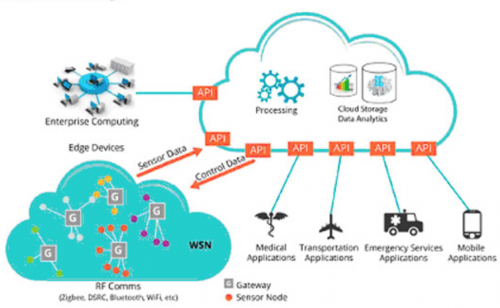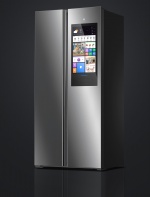Internet of things
The Internet of Things (IoT) is a system of interconnected devices and objects that communicate and interact through a network. IoT enhances normal everyday objects into “smart” ones, by imbedding them with electronics such as sensors, monitors, processors, microchips, and other forms of hardware. IoT devices can transmit real-time data, perform analytic functions, and utilyze AI-based machine-learning algorithms to become “smarter” and create more value for the user. IoT is meant to transform real world information into digital data, which can give insight in how users interact with their devices.
Contents
History
While the concept of connecting ordinary objects had been around since the 1970s and 1980s, such as embedded internet and pervasive computing innovations, IoT’s modern roots began in the 1990s. In 1990, Epilogue Technology computer programmer, John Romkey, engineered a networked toaster to display at the Interop Internet networking show. Romkey was able to remotely turn the toaster on and off through an internet connection. Although the device was rudimentary, it demonstrated how basic everyday objects, such as kitchen appliances, could be embedded with electronics and network connectivity to function remotely.
In 1998, Mark Weiser, Chief Scientist at XEROX PARC, engineered a water fountain with internet connectivity. It was designed to access online financial information about the New York Stock Exchange, and the flow and height of the water corresponded to the market’s changes in volume and price changes.
The term “IoT” was attributed to Kevin Ashton in 1999. While working at Procter & Gamble, Ashton wanted to incorporate tracking capabilities into P&G’s products. He advocated inserting radio-enabled frequency microchips into lipstick packages so that stores could better track inventory, and helped pioneer smart packaging systems. Ashton’s contributions exemplified the benefits that IoT technology could provide to retail and inventory control.
In 2000, LG Electronics released the Digital DIOS, which was an internet-connected refrigerator. The fridge contained an LCD panel on its door, which had video-messaging, electronic writing, data memo, and MP3 functions. The fridge could also provide information such as its inside temperature, freshness of foods, nutrition levels, and recipes. It also contained an internal webcam that scanned and tracked food content. The fridge ultimately failed due to its high price and required network connection, but it symbolized new innovations that were developing in kitchen appliance IoT devices. These first generation IoT devices helped foster in a new generation of technologies in the 21st century.
How IoT Works
IoT functionality has four main components: hardware, connectivity, data processing, and user interface output.
Hardware
Sensors, monitors, microchips, and other hardware, are the actual components that collect data. If the IoT object is a oven, internal sensors can collect heat information and cameras can collect images. If the IoT object is a wearable, sensors can collect heartbeat and sleeping pattern information, while microchips collect geolocation tracking data.
Connectivity
Network connectivity transmits data collected by IoT hardware to the user. IoT devices can communicate via a range of networks, such as cellular, satellite, WiFi, Bluetooth, Ethernet, and others. Each type of network has its advantages in network range, power consumption, and bandwidth. Cellular and satellite networks offer high range, and high bandwidth capabilities, yet they consume large amounts of power. WiFi, Bluetooth, and Ethernet networks have low power consumption and high bandwidth, yet they have low range, and can only transmit data locally. Modern IoT devices transmit data to Cloud applications, which offers centralized high data storage capacity, and analytic functions.
Data Processing
Once the data gets transferred to the Cloud via network APIs, it can perform data processing functions with analytic software. During this process, data architecture systems filter, aggregate, route, store, analyze, process, model, and then share data with user devices. Data is cleaned, and inaccurate or missing data is improved. Notable tech companies, such as Salesforce, Amazon, and Oracle have developed Cloud software applications that specifically manage large volumes of data and provide real-time outputs.
User Interface
That information can then be accessed in a user-friendly interface, which may be through a text, notification, feed, or browser. An IoT user interface can take many forms. For example, if you have an IoT based thermostat that is preset to maintain a range of temperatures, the Cloud will process the temperature data received from the thermostat’s sensors, and will alert the user via a phone notification or automatically change the temperature if it falls outside of the range. User interface design can be cross-device interactional, personalized, and provide the user with a unique experience.
Applications
The nature of IoT, and its ability to connect any type of object to produce real world data and increase value, means that it can be applied to virtually any industry or sector. Particular industries, however, have been especially successful in integrating IoT solutions.
Smart Home
Smart home IoT applications are the are widely used by consumers and homeowners. In 2018, Smart Home application companies received over $2.5 billion in startup funding, and there are over 250 companies in the industry. Popular applications are smart thermostats, connected lights, smart refrigerators and ovens, and smart door locks.
Wearables
Smart clothing and wearable devices have become trendy in the marketplace after the highly-anticipated and publicized releases of the Apple Watch and the Sony Smart Trainer. These devices collect data on fitness and health metrics to provide insight on user wellbeing.
Urban Design
IoT applications are used to designed Smart cities, which allow administrators and public workers to remotely control and maintain public utilities and infrastructure. City officials can embed sensors into traffic lights to reduce traffic congestion, outside of industrial plants to monitor and reduce pollution, and around high volume crime areas to improve policing.
Energy
Smart Grid IoT applications utilize electricity supplier and consumer information to improve efficiency, reliability, and cost. Suppliers can use IoT applications to measure and analyze the duration and location of power outages, and consumers can better monitor their energy consumption levels.
Transportation
Smart cars use IoT sensors to increase operation, maintenance, and safety metrics. Side-door sensors detect oncoming vehicles, remote devices unlock doors and start engines, and cloud-connected applications monitor maintenance levels and warn of needed repairs.
Healthcare
Connected healthcare systems can remotely monitor and measure patient health. This information can be used by doctors to recommend treatments, the healthcare industry to measure the usefulness and effect of products and drugs, and users to monitor their own health metrics.
Ethics =
Privacy
While IoT presents many consumer benefits, the fact that it connects inanimate objects to the internet presents privacy challenges. IoT devices generate more data and network that data to Cloud applications and connected devices. This creates a space for third party actors to access more data which before the invention of IoT, was nonexistent and unobtainable. Whenever consumers agree to third party data access, the legal Third-Party Doctrine states that they lose some expectation of privacy. Consumers may unknowingly consent to IoT companies and Cloud providers establishing backdoor channels to analyze the data generated by their consumers. First-party providers could additionally market IoT-generated data to advertisers and data broker.
Security
Network connectivity enables IoT devices to communicate with users, but it also presents network/data breach liabilities. IoT devices function on lower cybersecurity standards. IoT still uses low-grade, 2G and 3G networks to transmit data, which are less secure than than new generation networks. Faulty cybersecurity standards open up possible hacking and cyberattacks. Consumers would not want data exposed regarding their IoT heart monitor, connected household security system, or smart car. Even non-crucial information, such as data from a connected household lighting system, can indicate when a house is empty or not.





